Header logo
header top contact widget
Implant Placement
Why Seek A Periodontist For Dental Implants
Posted on Jul 13, 2021 by William J. Claiborne, DDS MS
Like many people, I value my relationship with my Internist. Through his care, I am confident that he understands my specific needs to oversee all aspects of my health.
Some of this care occasionally involves being referred to a specialist. For example, my Internist may advise me to see a dermatologist for a particular skin condition. Together, my internist and the dermatologist are able to work in unison so I’m receiving the proper treatment plan according to my particular needs.
I am also a specialist in the dental field. I am a periodontist, which is a specialist who receives most patients through referrals by a general dentist or another dental specialist. This is because a periodontist offers a unique set of skills as well as an advanced level of understanding when it comes to oral tissues and dental implants.
The American Academy of Periodontology defines a Periodontist as: “A periodontist is a dentist who specializes in the prevention, diagnosis, and treatment of periodontal disease, and in the placement of dental implants. Periodontists are also experts in the treatment of oral inflammation. Periodontists receive extensive training in these areas, including three additional years of education beyond dental school. They are familiar with the latest techniques for diagnosing and treating periodontal disease, and are also trained in performing cosmetic periodontal procedures.”
(https://www.perio.org/consumer/what-is-a-periodontist)
To reach this specialty requires an individual to be highly committed. A periodontist begins education by completing 4 years of college (undergraduate training) and then continues another 4 years in dental school to earn a doctorate. To specialize in Periodontics, he or she must further their education for another 3-4 years before completing the stringent requirements for a specialty certification in periodontics.
In addition to treating all phases of periodontal (gum) disease, a periodontal specialist is uniquely qualified to reshape gum tissues. This may be performed to correct a “gummy smile” or even out a smile line through crown lengthening. Periodontists also specialize in the diagnosis and placement of dental implants.
The advantages of a periodontist in dental implant treatment are multi-faceted. This specialist is trained to understand the intricate concepts involved in selecting the proper type of implant and skilled at placing implants at proper depths and angles. A periodontist is also able to optimize patient comfort during treatment and throughout the healing phase.
Using his or her advanced training in the diagnosis and placement of dental implants, a periodontist can help you enjoy a higher potential for dental implant treatment that lasts a lifetime. There are a number of reasons you should strongly consider having a periodontal specialist involved in dental implant treatment, including:
SELECTION OF IMPLANTS – Dental implants come in a wide array of shapes and sizes. Each system is designed to accommodate certain needs and preferences. For example, some implants are designed to support a full arch of teeth while others can be placed in areas where a great deal of bone loss has occurred. The selection of the implant type that is appropriate for your needs and goals requires a unique understanding of all implant types. That is, a periodontist can select the type that will work best for you rather than go with the one or two in which they have received training.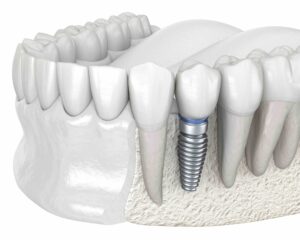
PLACEMENT OF IMPLANTS – In addition to selecting the best type for your needs, proper placement of implants has a great deal to do with having a successful outcome. When an implant that is too long, for instance, is placed in bone that is too shallow, it can have future repercussions that may require its removal. This could occur when a lower implant is placed too close to a nerve that runs horizontal through the jaw bone (mandible). Or, when an upper implant is placed in shallow bone, it can work its way into the sinus cavity. A periodontal specialist considers intricate factors that can effect your potential for success.
STRUCTURAL ISSUES – In addition to the factors involved with bone loss, other issues can ‘make or break’ having a successful treatment outcome with dental implants. For example, for people who have bite misalignment or TMJ disorders, they may be grinding or clenching their teeth during sleep – often unknowingly. Telltale signs of ‘bruxing’ including remaining, natural teeth that are chipped or worn. These forces are enough to crack a walnut. When dental implants endure these forces, especially during their ‘healing’ phase, there is greater risk for implant failure. A periodontist considers these issues prior to your treatment, helping you to bypass problems that can result in eventual removal.
INDIVIDUALIZED TREATMENT CONSIDERATIONS – Our goal is to help you get the most from your dental implants. When there are individual habits or preferences that can complicate success, we work with each patient to help them enjoy their dental implants for a lifetime. For smokers, we advise ways to support saliva flow and minimize oral bacteria levels. For people who take certain medications that can interfere with oral moisture, we recommend methods to keep the mouth properly hydrated. And so on. We want to make sure your care is individualized so your potential for implant success is high!
OPTIMAL COMFORT – For added comfort and relaxation, we offer Oral sedation or I.V. sedation (twilight sleep) for most procedures for those who want or need these options. Both sedations are administered to the highest standards of safety possible. Our sedated patients are closely monitored throughout treatment with advanced safety equipment and trained professionals. Oral sedation is a pill that helps patients relax. It also has an amnesiac effect, leaving most with little or no memory of treatment afterward. I.V. sedation places the patient in a deeper sedative state, also erasing memory of the procedure. At our Asheville office, Biltmore Periodontics administers sedation with the involvement of a highly-trained doctor of anesthesiology for optimal comfort and safety.
For individuals who wish to replace one or more missing teeth, it makes sense that dental implants have become the leading preference. Dental implants restore the look, feel, and function like that of natural teeth. They also help to prevent bone shrinkage that occurs when tooth roots are no longer present in the jaw bone. This process is known as resorption.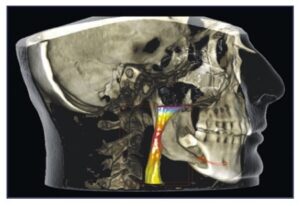
Resorption is what contributes to changes in facial appearance when the bone structures that give the face its shape start to shrink. When tooth roots no longer exist in the jaw bone, the stimulation once provided to the bone no longer exists. This causes the bone to shrink, or ‘resorb.’
As the bone mass declines in height and thins out, changes in facial appearance slowly evolve. For example, as the jaw bone thins, deep wrinkles form around the mouth. Eventually, the corners of the mouth will turn down even in a smile. Jowls form on each side of the face as facial muscles detach from the shrinking bone structure.
As the jaw bone continues to shrink, the chin becomes more pointed and the nose seems to get closer to it. This leads to a collapsed mouth that is known as a ‘granny look.’ This look ages the appearance of an individual far beyond their actual years.
Among the many benefits of dental implants, they also provide stimulation to the jaw bone. This helps to halt the process of bone loss. For those who have already lost a great deal of bone, bone rebuilding procedures can be performed to restore a healthy, more youthful face shape.
In addition to all the advantages of care through a periodontist, our Asheville periodontal office features some of the most advanced technology available. This includes laser dentistry and cone beam imaging as well as highly-advanced computerized options.
If you’ve considered dental implants to replace missing teeth, we invite you to consult with us during a private consultation appointment. A referral is not necessary. During this time, we will discuss your needs and goals as well as any concerns regarding comfort or costs.
To schedule, call (828) 274-9440.
Don’t Smoke? Living Or Working With A Smoker Creates Higher Risks Than Once Thought.
Posted on May 14, 2021 by William J. Claiborne, DDS MS
I doubt there is anyone in the U.S. who smokes tobacco who is unaware of the fact that it’s an unhealthy habit. Although the heart and lungs are more widely associated with the health risks of smoking, many people miss the fact that it is also damaging to the tissues in the mouth.
Consider the devastating statistics of COVID-19 related deaths in the U.S., nearing the 600,000 mark. Yet, when it comes to your oral health, cigarette smoking is responsible for more than 480,000 deaths per year in the United States. For people who don’t smoke but live or work with a smoker, secondhand smoke exposure accounts for over 41,000 of these.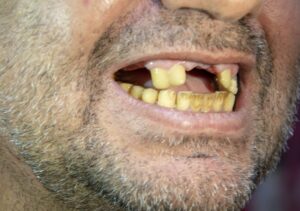
For nonsmokers who are victims of secondhand smoke, that’s a tough statistic to accept.
Just how harmful is secondhand smoke? British researchers recently released some interesting findings along these lines. Their studies included several major countries and tracked nearly 7,000 adults, with nearly half being exposed to secondhand smoke. The findings showed that breathing in the smoke of another person’s cigarette can increase the risk of oral cancer by more than 50 percent. These cancers include lip, mouth and throat cancers.
On average, smokers die 10 years earlier than nonsmokers. For every person who dies because of smoking, at least 30 people live with a serious illness related to smoking. Smoking leads to disease and disability and harms nearly every organ of the body.
When considering the mouth, smoking can create costly problems in addition to a higher risk of tooth loss.
Twenty years of research shows that cigarette smoking is a risk factor for periodontitis. A smoker is 2 – 3 times as likely to develop periodontitis, which is an advanced stage of gum disease. In addition to increased prevalence, smokers also experience greater severity of gum disease.
Nicotine (in any form) has been shown to reduce blood flow in the gum tissues in the mouth. Pipe smoking can be worse than cigarettes due to the higher temperatures generated in the upper jaw. When it comes to dental implants, smoking is a risk factor for failure. It is also detrimental for conventional bridgework.
Cigarette smoking has long been associated with serious oral conditions, including periodontal (gum) disease, bone loss, tissue loss, and tooth loss. For smokers who opt for dental implants to replace missing teeth, they have a higher risk of peri-implantitis, which is inflammation of the soft and hard gum tissues surrounding a dental implant. To no surprise, smokers have a higher incidence of dental implant failure.
In an article published by the Journal of International’s Society of Preventive & Community Dentistry as far back as 2012, it warned that smoking can impact the rate of dental implant success, accounting for up to 20 percent of failures.
“Clinical trials of endosseous implants consistently rate smoking as a primary patient-centered risk factor for implant loss.”
https://www.ncbi.nlm.nih.gov/pmc/articles/PMC3894084/
It is common knowledge that the nicotine in cigarettes, e-cigs and ‘chew’ is an addictive drug. Some concerning quotes shared by the Oral Cancer Foundation are:
“Scientists have found that nicotine is as addictive as heroin, cocaine or amphetamines, and for most people, more addictive than alcohol,” states the article “Nicotine, Harder to Kick than Heroin,” published in the New York Times Magazine.
“Nicotine is similar in all critical measures to prototypic drugs of abuse such as cocaine, morphine and heroin.”
“Nicotine is a poison used as an insecticide.”
https://oralcancerfoundation.org/understanding/tobacco/tobacco-and-addiction/
Now, knowing the effects of secondhand smoke are likened to the non-smoking “victim” as inhaling half as many cigarettes as the user they live or work with, smokers should consider their habit in a different light.
While our Asheville periodontal dental office does not lecture or “guilt” our patients in any way, we feel they deserve to know the hazards of any risk factor related to the well being of their oral health. Without a doubt, smoking (whether cigarettes or vaping) is harmful to oral tissues and the potential to keep natural teeth.
In a report shared by Delta Dental, smokers are about twice as likely to lose their teeth than non-smokers, according to two 30-year studies at Tufts University in Boston. Their findings showed that men who smoke lose about 3 teeth for every 10 years of smoking, with women losing an average of 1.5 teeth per decade.
https://www.deltadentalins.com/oral_health/teethinpack.html
Every year, about half of smokers make some attempt at kicking the habit. Yet, only 6 or so percent are fully successful. All the while, the tobacco industry spends BILLIONS of dollars each year on cigarette and smokeless tobacco advertising and promotions.
According to the Centers for Disease Control & Prevention (CDC), in 2018 “$9.06 billion was spent on advertising and promotion of cigarettes and smokeless tobacco combined—about $25 million every day.” That’s more than $1 million dollars spent every hour of every day.
https://www.cdc.gov/tobacco/data_statistics/fact_sheets/economics/econ_facts/index.htm
While nicotine addiction means big money to the tobacco industry, it is enormously costly to our population. Now, knowing that secondhand smoke is so harmful to others, I hope our smoker patients will welcome our respectful support in their efforts to quit as we help them to maintain good oral health and keep their teeth (or dental implants) healthy for a lifetime of confident smiles.
If you’ve considered dental implants to replace missing teeth and smoke, please consult with us to discuss ways we can help you minimize the potential for dental implant failure. We want you to reap the benefits of a smile you’ll want to share proudly.
Call 828-274-9440 to schedule.
Advanced Skills & Technology Enhance Comfort, Speed Healing
Posted on Apr 27, 2021 by William J. Claiborne, DDS MS
If you’ve ever watched a cabinet maker, his skill and attention to detail is impressive. He knows the various wood types, understands the details of joints and angles, and respects the individual components as interacting pieces that will work harmoniously as a whole.
Because he has the tools and skills specific to his craft, the coming-together of this typically provides a ‘forever’ result.
In the periodontal specialty, our specific skills create a number of advantages for patients who have different needs. Some of these skills are not always obvious, yet they allow for a higher level of success, greater comfort, and less time required for healing.
A periodontist, as defined by the American Academy of Periodontology (perio.org), is:
“A periodontist is a dentist who specializes in the prevention, diagnosis, and treatment of periodontal disease, and in the placement of dental implants. Periodontists are also experts in the treatment of oral inflammation. Periodontists receive extensive training in these areas, including three additional years of education beyond dental school. They are familiar with the latest techniques for diagnosing and treating periodontal disease, and are also trained in performing cosmetic periodontal procedures.”
As an Asheville periodontal specialist for over 25 years, I’ve utilized my advanced skills to help patients with a variety of needs that involve the gum tissues. These include:
– Treatment of all stages of gum disease (gingivitis, pregnancy gingivitis, periodontal disease, periodontitis)
– Reshaping gum tissues for esthetic enhancement (crown lengthening, gingivectomy for ‘gummy smiles’, repairing areas of gum recession)
– Diagnosis and placement of dental implants
– Treatment of lesions or cysts in oral tissues
Although there are other treatments offered, our main goal is to provide the patient with a comfortable and positive experience within our specialized skills. We believe that patients will come to appreciate the advantages of having a healthy smile and understand how our involvement can create a healthier, more confident individual.
Here, our Western North Carolina periodontal dental office features some of the most advanced technology in dentistry. Many of these are not available in other dental offices elsewhere. Some of these features include:
LANAP With PerioLase MVP 7 – Laser-Assisted New Attachment Procedure is an advanced protocol that efficiently and effectively treats advanced gum disease with the added advantages of a dental laser. This offers a non-surgical alternative for patients with moderate to severe periodontal disease. LANAP treatment leaves very little discomfort and has a quick recovery time. It has also been found to stimulate bone regrowth in damaged areas.
3-D Cone Beam Imaging – Ideal for diagnoses and treatment planning, these images provide a clear view of the upper and lower jaw, used for: intricate review of endodontics; periodontics; orthodontics; implantology: TMJ; and prosthodontics, as well as dental and maxillofacial surgery. Because cone beam radiographs show sagittal, axial, and coronal planes, locating and tracking nerve canals optimizes implant placement. The process is quick, painless and at minimal levels of radiation.
CareStream Cone Beam Computer Tomography Imaging – This enhanced tomography works with 3D imaging for exceptional detail and range.
CS 3600 Intraoral Scanner – Rather than make impressions with bulky, goopy trays, this scanner quickly and comfortably captures digital impressions accurately and easily for creating precision models or appliances (crowns, inlays, onlays, bridges, orthodontic appliances and aligners, custom abutments). The scanner can also reach difficult–to–access areas in the patient’s mouth for superior results with improved patient comfort.
Computerized Dental Implant Placement – This advanced system for pre-surgical positioning of dental implants uses a 3D model of the patient’s jaw. Once the implant type is selected, a template is developed for optimal treatment success, even for complex cases.
In addition, we offer a unique environment for comfort. We understand how dental fear or anxiety can cause people to delay or avoid having dental treatment, sometimes for decades. Too, when regular dental cleanings and check-ups are not maintained, the results often culminate into more complex problems (and necessary repairs) in the future.
We help patients understand that these fears and concerns are not unusual. Our doctors and staff respect each patient and provide gentle, compassionate care – at every appointment.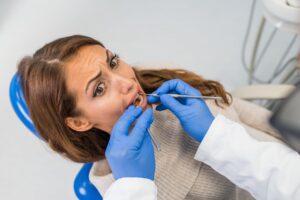
For those who have high fear levels, we offer several sedation options, including oral and IV sedation. Oral sedation is a pill that helps patients relax. It also has an amnesiac effect, leaving most with little or no memory of treatment afterward.
I.V. sedation (also known as ‘twilight sleep’) places the patient in a deeper sleep state and erases memory of the procedure. It is administered by a doctor of anesthesiology for optimal comfort and safety. In our Asheville office, anesthesia is overseen by a Medical Doctor (MD) who is a board certified Anesthesiologist.
With both sedation options, patients are closely monitored with advanced safety equipment throughout treatment.
How I would describe the difference between a periodontist and other dental specialists is in how gentle and respectful we are to the tissues in the mouth. These are tender layers that significantly affect the appearance of a smile and the health of teeth. By understanding the techniques to minimize incisions while effectively treating each area in the mouth, a periodontist is your expert.
We feel you’ll find no better periodontal dental environment. Call 828-274-9440 to learn more or to schedule a consultation appointment. New patients are always welcome and a referral is not required.
How Straight Teeth Support Oral Health & Dental Implant Success
Posted on Apr 19, 2021 by William J. Claiborne, DDS MS
As a Periodontist, I often work in conjunction with other dental specialists to provide an optimal outcome at the direction of the patient’s general dentist. By combining our specific skills, we are able to create a complete-care integration of services tailored to attend to unique or complex needs.
For example, as a specialist in the treatment of gum disease and placement of dental implants, my skills are beneficial for ideal outcomes as well as in long-term success. This is especially true when I note signs of bite misalignment in a dental implant patient.
The ‘bite’ refers to how the top row of teeth fit to the bottom row. These upper and lower teeth should “rest” together harmoniously. This fit has a great deal to do with a balanced alignment that is far reaching.
For instance, when teeth are not in proper alignment, there is an interference in the
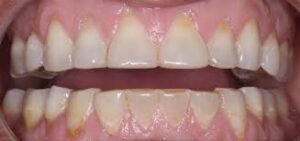
Teeth worn down from grinding, or “bruxing”
interaction of biting, chewing and even speaking. This misalignment can strain the jaw joints as well as the muscles of the face, extending out to neck and shoulder muscles.
Bite misalignment is a common cause of temporomandibular joint (or TMJ) disorder. The TMJ are located on each side of the head and hinge the lower jaw to the skull. Continual stress on these joints can lead to an inflammation that triggers a series of problems.
In most cases, bite misalignment is what triggers night-time clenching and grinding. Known as bruxing, this action can result in chipped, broken and fractured teeth. Other symptoms associated with a misaligned bite – and thus, TMJ problems – include frequent headaches and migraines, ear ringing, dizziness and difficulty opening the mouth fully.
As an Asheville periodontist, I also see how bite misalignment can cause the gums to recede. This occurs as misaligned teeth tilt or turn, which causes an unnatural pulling on the gum tissues surrounding the tooth at its base. As more vulnerable sections of the tooth are exposed, the risks for developing cavities and gum disease increases.
When it comes to dental implants, success rates can be greatly compromised with the presence of clenching and grinding. Here’s why…
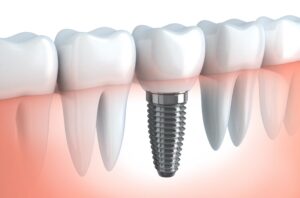 A dental implant is placed in the jaw bone, serving as a replacement tooth root. During the first 3 – 6 months, the bone grows around it, securing it firmly into the bone surrounding it. This process is known as osseo-integration.
A dental implant is placed in the jaw bone, serving as a replacement tooth root. During the first 3 – 6 months, the bone grows around it, securing it firmly into the bone surrounding it. This process is known as osseo-integration.
It is during this time that an implant is most vulnerable to the forces that clenching and grinding exert. When you consider that implants require up to 6 months to become fully integrated into the bone structure, the stress from grinding or clenching can disrupt this process.
According to an analysis published in Dental Implants (Oct. 2015), and using data from ten publications, bruxers experienced a 6.45 failure rate (as compared to 3.65 in non-bruxers.(https://journals.lww.com/implantdent/fulltext/2015/10000/bruxism_and_dental_implants__a_meta_analysis.5.aspx)
My involvement helps to detect what is not always apparent, yet could have a tremendous impact for a successful outcome. Working to help dental implant patients avoid problems in the future is my goal and helps to protect the patient’s investment.
Certainly, misaligned teeth that are crowded or crooked tend to bunch up together. These teeth often form tight angles, creating hard-to-reach areas that make thorough toothbrushing more difficult. As oral bacteria remain, these areas become breeding grounds for an overload of bacteria that run rampant. This can lead to the formation of cavities and the development of gum disease.
The problem of misalignment can result in a vicious cycle: (1) greater risk for gum disease; (2) higher potential for TMJ disorder; (3) increased risk for tooth loss; (4) more likelihood for dental implant failure.
Consider that periodontal (gum) disease is the nation’s leading cause of adult tooth loss. Thus, a condition such as bruxing, which can lead to gum disease, can increase the potential for tooth loss. And, in replacing teeth, bruxing can continue to compromise tooth replacement success (with dental implants or other means, such as crown-&-bridge).
If you’re considering dental implants but suspect you clench or grind your teeth, we’ll discuss ways you can achieve your smile goals and protect your investment.
Call our Asheville periodontal dental office at 828-274-9440 to schedule a consultation.
Recent Posts
Categories
Archives
- September 2024
- August 2024
- July 2024
- June 2024
- May 2024
- April 2024
- March 2024
- February 2024
- January 2024
- December 2023
- November 2023
- October 2023
- September 2023
- August 2023
- July 2023
- June 2023
- May 2023
- April 2023
- March 2023
- February 2023
- January 2023
- December 2022
- November 2022
- October 2022
- September 2022
- August 2022
- July 2022
- June 2022
- May 2022
- April 2022
- March 2022
- February 2022
- January 2022
- December 2021
- November 2021
- October 2021
- September 2021
- August 2021
- July 2021
- June 2021
- May 2021
- April 2021
- March 2021
- February 2021
- January 2021
- December 2020
- November 2020
- October 2020
- September 2020
- August 2020
- July 2020
- June 2020
- May 2020
- April 2020
- March 2020
- February 2020
- January 2020
- December 2019
- November 2019
- October 2019
- September 2019
- August 2019
- July 2019
- June 2019
- May 2019
- April 2019
- March 2019
- February 2019
- January 2019
- December 2018
- November 2018
- October 2018
- September 2018
- August 2018
- July 2018
- June 2018
- May 2018
- April 2018
- March 2018
- February 2018
- January 2018
- December 2017
- November 2017
- October 2017
- September 2017
- August 2017
- July 2017
- June 2017
- May 2017
- April 2017
- March 2017
- February 2017
- January 2017
- December 2016
- November 2016
- October 2016
- September 2016
- August 2016
- July 2016
- June 2016
- May 2016
- April 2016
- March 2016
- February 2016
- January 2016
- December 2015
- November 2015
- October 2015
- September 2015
- August 2015
- July 2015
- June 2015
- May 2015
- April 2015
- March 2015
- February 2015
- January 2015
- December 2014
- November 2014
- October 2014
- September 2014
- August 2014
- July 2014
- June 2014
- May 2014
- April 2014
- March 2014
- February 2014
- January 2014
- December 2013
- November 2013
- October 2013
- September 2013
- August 2013
- July 2013
- June 2013
- May 2013
- April 2013
- March 2013
- February 2013
- January 2013
- December 2012
- November 2012
- October 2012
- September 2012
- August 2012
- July 2012
- June 2012


